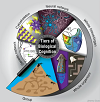
Oligos Treating Telomeres - 2011 SENS5 Will Stoyanov
Main Video
Title: Anti aging oligos 5'-(TTAGGG)n-3' treatment maintaining telomere length in vitro in human skin cells overcoming senescence and the t-loop deletion factor
Author: Will Vladimir Stoyanov Anti Aging Center
Abstract: Telomere shortening is thought to play significant role in cellular aging contributing to human aging and longevity. Critical telomere shortening affects different genes, as human genomes vary, which is why the cascades differ, hence the different effects, organ failures and cancers. For years telomere length maintenance has been targeted. Currently telomerase activators and oligomers addition treatments are available to purchase. Variations of telomere shortening occur within same type of tissue, as well as different tissue types, from same and different individuals. Each old tissue is a mix of mainly old cells with short telomeres less than 5KB and some new cells with normal telomeres more than 15KB. To increase ~20% thus significantly the life span of these human skin cells mix, there were many telomere shortening factors considered, including RNA primers and the t-loop deletion factor. Ideal treatment appears to be ~5KB 5'-(TTAGGG)n-3' oligos dose spread over 1 year, or if administered at once it needs additional dose of 5'CCCTAA3', so that they bind inside the nuclei to reach the ~5KB extension at once. All oligos (TTAGGG)1-50 work, so dosage, frequency and cost considerations suggest as much cheaper to use shorter oligos, e.g. where n=15, 10 or even 5. Treatment per year per organ cost much less compare to telomerase activators. Treatment is harmless, so in 10 years treatment can be repeated for another ~20% and if done again another ~20%. Tests have not been testing to increase human skin cells life span for more than 52%, but theoretically it should work for as long as used. Multiple organs treatment is also allowed as the treatment is totally harmless. Oligomer treatment prise is per organ, thus the more organs the higher the prise. However even if the whole body is treated at once the prise will not exceed the telomerase activators prises. Doses are according to transfection efficiencies of the DEAE-Dextran. Trial and error adapt dose and frequencies, according to the individual genes and their interaction with the environment. Additional immortality control is preferable to take cells into a new culture and stop their treatment to see if they will immortalise, which will indicate too higher dose and/or too frequent. The opposite will be if the cells live as long as the non treated cells control, which would indicate lower dose and/or lower frequency of treatments. Dosing can be spread once a week or two weeks. Elderly and progeria patients already or close to critical threshold are to use this treatment. Potential negative effect/s could occur for the minority of cells if their telomeres are over extended, which could result in chromosomal abnormalities, which could lead to other abnormal cascade/s. Oligomer therapy is harmless in difference to telomerase therapies. Oligos bind to complementary DNA and also form weak 5'-3' bonds between oligos, so polymerases and ligases are strong and efficient enough to integrate the oligos. Some individuals polymerases and/or ligases may not be as efficient, which may require long oligos therapies only, where cost doubles. Cheap, easy, effective and sufficient test was simply cell counting using iodine for live cells and trypan blue for dead cells. Culturing is efficient with both CO2 incubator and/or electric blanket, both require maintaining of temperature and pH. Every microscope with eyepiece x10 and objective x20/40x is sufficient. Photos were obtained with 3.2MP mobile-phone-cam. Theoretically telomere length maintenance is tissue independent, but ratios of old cells with short telomeres to new cells with normal telomeres is tissue dependent. This would suggest that tissues cannot be used as parameter predictions for relative telomere length in other tissues after treatment.
Other videos from BioScience
-

American Chemical Soci...
By: caliban
20 December 2019 - 11:47 AM -

Bioelectric Computatio...
By: Mind
12 December 2018 - 10:39 PM -

Bioelectric Computatio...
By: Mind
12 December 2018 - 10:39 PM -

The first head transpl...
By: caliban
04 March 2015 - 12:31 AM -

A Monkey Head Transplant
By: caliban
03 March 2015 - 11:12 PM -

NAD and Age reversal pt 4
By: to age or not to age
26 August 2014 - 06:49 PM -

NAD and age reversal pt 3
By: to age or not to age
26 August 2014 - 06:47 PM -

David Sinclair Intervi...
By: YOLF
17 March 2014 - 10:23 AM -

Caleb Finch
By: caliban
08 May 2012 - 09:14 AM -

SENS5 - The Future of...
By: jdgauchat
21 December 2011 - 07:44 PM









































